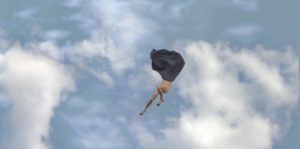Three holograms stand at the end of Deluge Contemporary Art Gallery in Victoria. If you stand at the right angle in front of them, you can catch a wrinkled handkerchief on each. Are they real? What do they mean?
Contemporary art puzzles us. It’s not about proportion, composition, or accuracy of imitating nature. It’s also not about easy contemplation—on the contrary, there are many discomforting questions.
“It’s a domain that has no rules or no particular agenda,” says Christine D’Onofrio, whose work is currently exhibited in Real Tears at Deluge. “We don’t have to sell anything; it’s sort of this space that you can just make conversations or provoke a new way of thinking.”

D’Onofrio received her bachelor’s of Fine Arts from York University and master’s of fine arts from the University of British Columbia. Her friendships with other art students and her interactions with the art community were influential on how she approaches the craft. In her process, the sense of community and the relationships that were more particular to feminist art practice play a key role.
“How do you make a new world when there is not an example of how to make that?” says D’Onofrio. “I make work more interested in the complications of new thinking; I’m using the detail of feminism because that’s something I know.”
D’Onofrio’s priorities as a contemporary artist lie in creating artwork that makes people question what they know and where that knowledge comes from. As an artist interested in activism, she says making people feel some sort of commotion from a situation they are encountering works better than just telling them to recheck their assumptions. She believes art can do that, and she tackles these concepts in her art while juggling a job as an art teacher at UBC.
“When your job entails that you go into all these other mindsets, it’s tough to ignore them all when you are trying to create your own work,” she says. “It’s a big challenge. The space of the summer is when I can start to find my own headspace again.”
When D’Onofrio is in that headspace, research dominates her art process. Research is not always a solitary activity, though. There are other artists to converse with and artwork to see and think—and talk—about.
“Sometimes it’s quite clear why I want to make a piece, so I use that negotiation to create the work; there are different levels I want to play with it,” she says. “Other times, it’s a lot of trial and error, trying different ways of attacking the subject, or even different materials and media.”
And yet, at the end of all this, if a work of art is not resolved in the way she wants it to be, she doesn’t hurry it. She differentiates her practice from a production model, and evidence of this can be seen in Real Tears.
“I wanted to play with this idea of something not being real,” she says. “It was only [when] I uncovered the ways I can execute and render that that the piece started to make sense. But it took me a very long time to make that piece [in Real Tears] because I didn’t really know how I was going to put it together.”
Real Tears is D’Onofrio’s response to feminism’s failures and potentials. The rendered handkerchiefs shown in the exhibit belong to her, her mother, and grandmother, who cried in them.
“I feel that my grandmother and mother had hoped for an idea of feminism to bring a newfound freedom to the next generation,” she says. “But it’s a difficult road—there are a lot of failures, there are a lot of new issues, as well as a prevalence of old issues.”
Real Tears
Until Saturday, February 24
Deluge Art Gallery
deluge.ws
